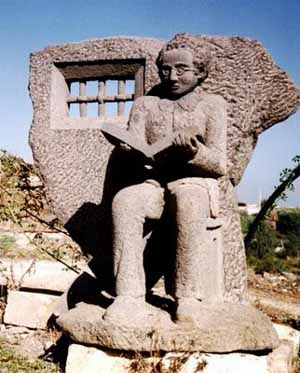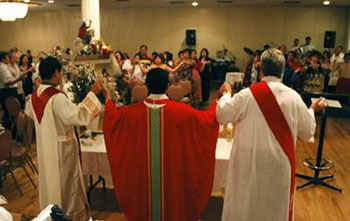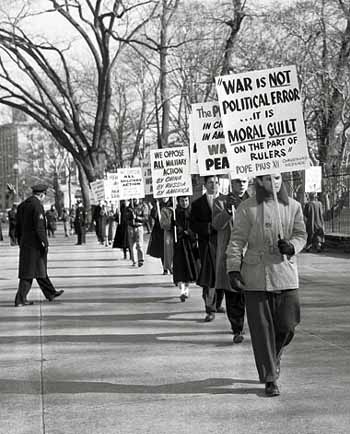 |
Socio-Political Issues
Are We All Gramscians Now?
Dario McDarby
Unfortunately the death in 1937 of the Italian Communist Antonio Gramsci did not kill his poisonous ideas. In fact, following his death and well into the last century, his toxins increased Socialism in the world to the point where all European nations and the United States became infected with them.
Most sadly, his brand of Socialism also contaminated the Holy Church, erupting before and after the revolution of Vatican II. Little do progressivist Catholics realize that the god they follow more is Antonio Gramsci, whom most have never heard of, and less our Lord and Savior, Christ Jesus. The Hierarchy would have it no other way, for their goal in the last 40 years has been to diminish the Catholic Faith among the faithful and zealously incorporate it with every heresy and error in its zeal for the idol of change.
Of course, progressivist pew-dwellers oppose anyone denouncing such a scandalous communist infiltration in the Church, like the Americans who still believe they hate Socialism, but don’t want to acknowledge we live under a socialist government and docilely serve and support it.
The primary evil of Gramsci
Gramsci is known for his idea of “the long march through the institutions.” He rejected revolutionary violence for revolutionary subterfuge and subversion, a more efficient form of attacking God-ordained and ordered society. He felt republican and democratic nations are less prone to violent change than to the subtle manipulation by a cadre of well-trained “soft revolutionaries” who enter and overturn traditional institutions.

A communist monument picturing Gramsci in prison |
The training grounds for these revolutionaries were the institutions of higher learning, especially the more elite universities, both private and public. A professional cadre of professors aimed their sights at the young, who in their idealism and immaturity were easier to convince.
Labor unions, still the bastion of old line communist influence, manipulated the working men and women, developing sensitivity toward socialist aims. Civil society, then, could be changed through political subversion and the institutions of a society co-opted and corrupted by wickedness.
The flash point of this new fangled revolution was the 1960s, when a full frontal assault was launched by the left on the institutions of the West. During this time, the Catholic Church had entered into the “modernization” of Vatican II, where countless Prelates and theologians opened fire on the Church’s institutions and traditions.
Since the 1960s, aided by the wickedness of various religious, secular, and political forces operating in the world, institutions, one by one, fell to the enemy. Gramsci’s “long march” proceeded, destroying important bulwarks in civil society, such as public morality and family life, with the legalization of abortion in the 1970s. Few saw this fall clearly. Many welcomed “changes” that seemed to be more “in the spirit of the modern world.”
Gramscianism was the quintessential political “meeting the modern world,” an idea driving the “spirit” of Vatican II. Eager to rid themselves of the so-called medieval Church, the enemies within clamored for this infernal meeting. They claimed the world did not need to change, the Church needed to change. Reminiscent of Lutheranism and its attendant evils, progressivists sacked Holy Church more effectively than any barbarian sack of Rome in ancient times.
We must remember that the violent changes in the Church did not occur suddenly, but were prepared over time by earlier progressivists who paved the way for Vatican II and its consequences. Working our way backward on that path, we can trace their origin successively in Modernism, Liberalism, the French Revolution, the Reformation, the Naturalism of the Renaissance, the heresies of the Middle Ages inspired by Judaic intrigue, and, even further, the ancient evil of Gnosticism. The trail starts from the Garden of Eden and ends in this sewer that is the modern world today.
The effects of Gramsci’s Socialism
First, we need to understand that Socialism and its effects are an inversion of Catholicism and its social doctrine. As Satan is the ape of God, so too is Socialism the ape of Catholicism. While Socialism was born from the Revolution, the Church was born from the Holy Ghost proceeding from the Father and Son. The former is new wine in the old bottle of Gnosticism, while the latter is from the Body and Blood of Christ.

The presider with the 'body of Christ' - the people |
Gramsci, an apostate from the Catholic Faith and a zealous, irredeemable atheist, hated the Church as much as what she founded, namely Western Civilization. Unlike neo-pagan feminists who seek a feculent “spirituality” in the dead branches of Celtic and Nordic mythology, Gramsci accepted a vague spirituality subordinate to his vile political naturalism and rationalism.
He also subverted the Catholic notion of man’s proper relation to God, by presenting man as god. For Gramsci, man cannot function well individually: as a social being he needs a collective knowledge to attain the aims of modern political society. So, the progressivist practices whereby the assembly of worshippers collectively becomes the ‘Body of Christ’ is a pseudo-religious version of political Gramscianism..
When the priest - since 1969 considered the president of the assembly - offers the hostia to the communicant, it no longer is the THE Body of Christ according to Catholic doctrine, but it is a symbol that the communicant enters into the collective body of those assembled in that particular progressivist church. The assembled masses become the Body of Christ collectively. This is Gramscianism in its full force in the new religion born from the “spirit” of Vatican II.
The individual enters into a collective reality or “church” that is different from the Holy Church. According to Personalism, so dear to John Paul II, man transcends himself and becomes greater than himself as “church.” Thereby this new church becomes the ape of the Catholic Church.
An enervated Church turned toward peace

Catholic Workers pacifist demonstration |
In Iota Unum, Dr. Romano Amerio said that the liturgical reform of Paul VI redefined the “militia of the heavenly army” (this is us!) to become the “multitude of the heavenly choirs” (this is the new church) (Sarto House, 1996, p. 620).
Instead of soldiers of Christ, as the Catholic Faith taught us to be as the Church Militant, we become socialist choirboys in the Conciliar Church and in society. This concocted religion of Vatican II hates the Church Militant and proclaims what we could call the Church Enervated.
Socialism wants to de-militarize society in order to enervate it. This is apparent in the modern clergy’s lust for “peace,” a version that Christ rejected in Matthew. The “peace” of the new church is appeasement, giving in to the demands of the modern world and its Prince.
An expressive example of this mania for peace is the Catholic (sic) Worker Movement of Dorothy Day and Peter Maurin, where collaboration with Communists, Socialists, Anarchists and unions like the Industrial Workers of the World allegedly sought “peace and justice” above all things.
Today, the true Catholic Church is in the catacombs, protected by few heroic Bishops, priests, and laymen who hold the Faith complete and undefiled. The rest of the world has fallen, and they sing: “We are all Gramscians now!”
Christ promised the gates of Hell would not prevail, that a remnant would remain … and in the end He will Triumph. We are the Church Militant and we sing the truth of The Word of God, and, come rack, come rope, we will prevail through Him and His Church led by Our Lord and His, ours, Most Holy Mother.

Posted January 17, 2011
Dario McDarby is a Catholic layman who writes the blog,
Watching the Wicked Seed

Related Topics of Interest
 Gramsci’s Influence on the Academia and Media Gramsci’s Influence on the Academia and Media
 Color Variations in Communism - Part I Color Variations in Communism - Part I
 Color Variations in Communism - Part II Color Variations in Communism - Part II
 Liberals, Modernists and Progressivists Liberals, Modernists and Progressivists
 The Progressivism of the First and Second Renaissances The Progressivism of the First and Second Renaissances
 A Socialist West? When? A Socialist West? When?
 The New Kremlin Bridgehead in Latin America The New Kremlin Bridgehead in Latin America
 Revolution and Counter-Revolution – Overview Revolution and Counter-Revolution – Overview

Related Works of Interest
|
|
Social-Political | Hot Topics | Home | Books | CDs | Search | Contact Us | Donate

© 2002- Tradition in Action, Inc. All Rights
Reserved
|
 |
|